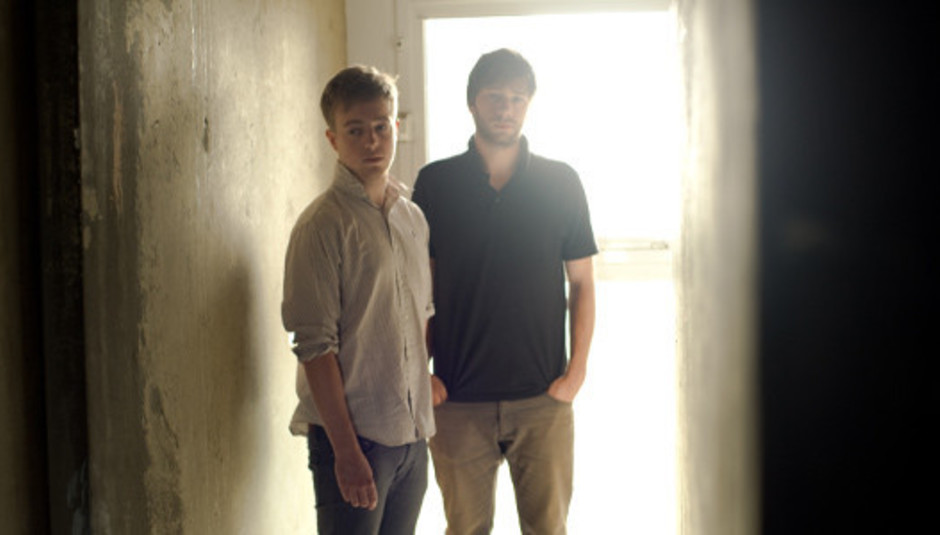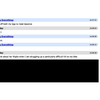So where and what exactly is dubstep in 2010? It’s getting ever tougher to pin down. In the last month alone we’ve seen Bristol’s Guido release an album of R’n’B styled pop gems, Ital Tek put together a second record that looks back towards early Autechre, and James Blake totally rewire Kelis and Aaliyah into the anthemic ‘CMYK’. The strands are unraveling so swiftly, and in so many different directions, that attempting to get a solid grasp is nigh on impossible. At this point it’s probably easier – and far more fun - just to hang on for dear life and enjoy the ride.
Mount Kimbie’s Dominic Maker knows this. Over the last year he has become part of a vanguard of young electronic musicians poised to take real steps towards wider, even mainstream, recognition. Alongside his bandmate Kai Campos he’s created yet another indefinable beast, one that seems to take real joy in refusing to bow to expectations, and avoids conventional song structures in favour of hazy, dreamlike composition. The duo’s debut full-length Crooks & Lovers is out this month, and sees them refine the delicate experiments of their first two EPs into a longer, more rounded statement of intent. The result is an album that follows a deliciously free-associative logic, veering wildly between bursts of perfect, fizzing pop (the chattering skip of ‘Carbonated’, with its talk of “basslines”, is strangely reminiscent of Puretone’s ‘Addicted To Bass’), glowing ambience (‘Ruby’) and buzzing UK garage (‘Blind Night Errand’).
“There are a lot of surprising melodic changes during the album,” admits Maker when we catch up with him for a chat about its coming release. “It keeps changing and evolving, which keeps it interesting, I guess. I listened to it in full again the other day, and noticed how it’s quite hypnotic in a sense. It really works in that way, especially when you’re traveling around listening to it.” This quality, he says, is at least in part down to the way it was written, using their live set-up as a basis to stack layer upon layer of percussion and melody. “We were very keen on building loops that run on a bit, which was something that came through from the live set.”
Indeed, if one word succinctly captures the essence of Crooks & Lovers, it’s hypnotic. Over the course of its length it forms a whole entity that seems to disregard the need for individual tracks, and the disjointed nature of opener ‘Tunnelvision’ and ‘Ode To Bear’ (“I think there’s about four sudden changes in that one!”, he laughs) is softened by repetitive elements that run throughout both. The overall effect is to shift the brain’s activity into a state somewhere between waking and dream. It’s officially called hypnagogia – a term much beloved by the Wire magazine - but Kimbie’s take on it has an entirely different feel to similar regions explored by US groups like Emeralds or Oneohtrix Point Never. Instead, they capture the headspace you might reach during a long journey by train or coach, or while lost in the sensory bliss of a seamlessly mixed techno set. “I know exactly what you mean,” he agrees. “Your breathing’s really steady, and you’re just somewhere inside yourself. Thinking about it now, a lot of the tracks we finished were developed after we went to Berlin and played a gig there. I was just blown away by that kind of environment, it was incredible, you became lulled into this semi-awake state. I suppose once we got back that may have had some effect on the way we finished things off.”
When asked how the album came about, Maker explains that the development of their live set was crucial to the writing process. “The initial ideas started to come together at least six or seven months ago. It’s been a very gradual process, and we’ve been playing live a lot over the past few months, so it’s been all about taking ideas and working on them midweek between shows… Constructing the live set was really helpful in terms of actually finishing off ideas. We slowly realised that if something sounds good at the time, don’t sit there and overproduce it for weeks and weeks – there’s no need. Doing it live really helps with that, because you decide then that it’s been recorded and there’s no need to change it.”
Crooks & Lovers possesses a nervy, haunted feel, a tension that’s only heightened by the fragments of living and breathing reality that lurk just beneath its surface. During the early stages of writing the pair, along with erstwhile live collaborator James Blake, found themselves taking field recordings at a wind tunnel by the sea in Brighton. “[We] sat there for about three hours or something, just recording the sound in that tunnel, and I think that’s the only real recurrent theme throughout the album. There’s definitely a reverb-y sound we try to achieve, which definitely came from sitting down and listening to those sounds we recorded there. I think it does carry on throughout the album as a whole theme; less that you actually hear the wind tunnel, but more an echoing, reverbed aspect to things.”
It certainly lends the whole record a tangible sense of loneliness. “Definitely. I think we’ve been surprised at a lot of peoples’ initial reactions to hearing the tracks. We’ve had a lot of people saying it’s really morose, when [writing it] really wasn’t a morose process at all! I think using a lot more guitar really added to that, because neither of us are particularly technically advanced at the guitar - a lot of it was like ‘Let’s just use loads of reverb and it’ll sound fine!’ I think that does give it this slightly deeper kind of feel.”
Certainly Mount Kimbie’s increased use of live samples and instruments lends their newer material an organic, natural sense of pace that exceeds even that of their earlier EPs. During ‘Blind Night Errand’, an abrasive and bass-heavy opening sequence suddenly springs wide open to allow wispy voices to dance around the beat, and the centre of ‘Field’ is suddenly torn in two by a gorgeous, overdriven guitar figure. Was there a specific atmosphere you were trying to create? “Well, we didn’t go into it thinking that we wanted to portray a certain mood… There’s a lot more hip-hop and a bit more soul to it, I think. There was a sound we both had in our heads that we couldn’t really describe, but the second track on the album, ‘Would Know’, encapsulates it. When we were making that track, that was the first time we thought, ‘Right, this is the sound we like, this is what we’ve been aiming for.’”
It’s a sound that’s been consistently tough to define, even since the release of their debut EP, Maybes, with its spectrally beautiful title track. Are they surprised at the amount of love Maybes still seems to gather? “It is surprising, yeah. It was only the second track we worked on together. The beginning guitar part was actually recorded about a year or so before we even started as Mount Kimbie. Kai had recorded it in his bedroom, and he had so many effects on there that we spent about two months trying to work out what he had actually played! Originally it was a totally separate track, but we really liked those big chord crashes and thought, ‘We need to do something with that!’”
Upon its release, through Scuba’s consistently exciting Hotflush imprint, the duo’s sound was immediately filed alongside the other dubstep mutations released on the label. But as with many artists nurtured within that community at the time, alongside others like FaltyDL and James Blake, Kimbie’s music shares little with ‘dubstep’ in the traditional sense of the word. Yet they share an anxiety and restlessness with Blake’s slow motion soul and FaltyDL’s strip-lit two-step that strongly ties them to its lineage. What all three achieve - albeit each in entirely different ways – is music that’s defiantly individual, but remains close to the genre’s original spirit of experimentation.
A lot of the producers working within that loosely defined space take great efforts to distance themselves from lazy genre stereotyping; do Mount Kimbie still – or did they ever – identify with the dubstep community? Maker is wary of fostering inaccurate comparisons, but less overly dismissive of the notion than many of his contemporaries. “Genres don’t really interest me at all. If I like something I like it. There’s room to go outside the limits, be free and not worry about what you should be listening to. I think it gives you an excuse to enjoy yourself more! I think the key point really was that when we first started we were both ridiculously into that sound. The stuff coming out at that time was just fantastic. With the first Bass Clef album [2006’s A Smile Is A Curve That Straightens Most Things] and Actress’ early music you could immediately tell that there was room there to express emotions. It didn’t need to be this rigid, cold electronic sound, there was real space for development. I still think it’s exciting to be even vaguely linked to that, and I suppose the connection with Hotflush was a crucial factor in that link.”
Alongside Kode9’s reliably unpredictable Hyperdub, Hotflush has been the best example so far of an ostensibly dubstep-related label working hard to challenge the genre’s perceived boundaries. In doing so, they have managed to assemble a formidable label roster. As well as Mount Kimbie’s first two EPs, in the last year alone Scuba’s label has been responsible for the release of Joy Orbison’s ubiquitous ‘Hyph Mngo’ and his own frequently astonishing Triangulation long player, as well as material from a host of lesser known figures: Sigha’s minimalist, broken techno, experimental cuts from Pangaea and Untold, and upcoming EPs from rising producers George Fitzgerald and Sepalcure.
It must be exciting to be involved with such an innovative community of musicians? “Yeah, absolutely. I mean, when we first had contact with Paul [Scuba], we didn’t really know what Hotflush was, it was very early on. But just seeing the way they’ve developed is great, and the artists they’re picking up at the moment are absolutely unbelievable. It just feels right. They’ve been really supportive and the music they’re putting out is fantastic, so it’s just great to be a part of that movement.” He pauses for a moment. “And I do think it is a movement. It seems to have broken down that barrier around how things ‘should be’. I just find it amazing that they manage to pull off releasing that SCB edit of [Kimbie tune] ‘Vertical’, and then putting out the new Sepalcure stuff, which is completely different. With Sepalcure in particular, you know when you hear about thirty seconds of a song and you think ‘This is going to be very big’? I really do think they’re going to be massive.”
So what now for Mount Kimbie now that Crooks & Lovers is on its way out into the big bad world? “It’s just nice not to have a plan. The day the album was finished, we both felt like we could just start writing without a cause again. Kai’s been making lots of juke recently, and I sent him something yesterday that sounds like a full-on indie track! We’re both so interested in so many different areas of music that it’s just been nice to experiment a bit. It’s odd though, because it’s still got a certain sound to it – you can definitely still tell it’s Mount Kimbie. It’ll be interesting to see what we come up with next.” He laughs. “Anything without a genre, really.”






















